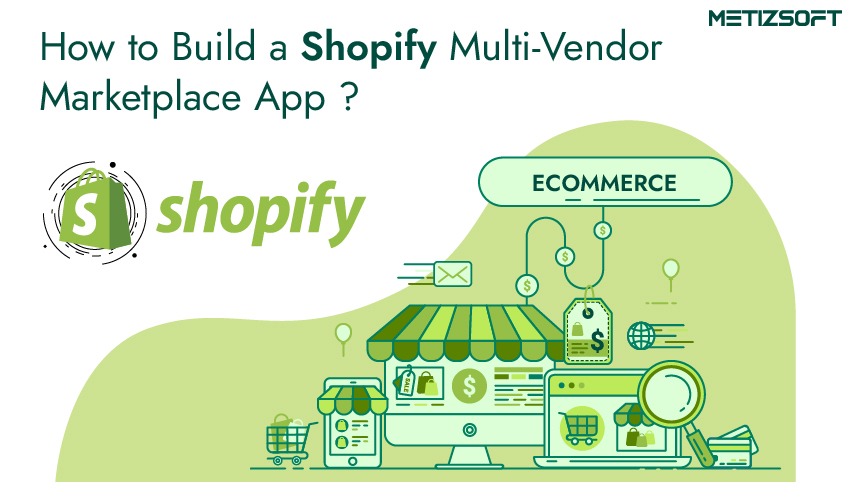
With eCommerce (Retail Sales) expected to reach $ 4.3 trillion worldwide in 2025. It is clear that demand for multi-vendor marketplace apps is becoming increasingly popular among entrepreneurs and established businesses. Platforms like Amazon, eBay, and Etsy have already implemented and exemplified the success of this model. Now, it’s time for you to create a multi-vendor marketplace and drive e-commerce success! But how can you build it? On which platform?
The answer is Shopify, a leading eCommerce multi-vendor development platform! Shopify provides the environment, tools, built-in functionality, and components to create a Shopify multi-vendor marketplace app with advanced features.
In this blog, we will learn crucial insights about the Shopify multi-vendor marketplace app. We also discovered the steps required to create a Shopify multi-seller app and the benefits it can align with to generate high-end revenue.
But at first:
Table of Contents
What is a Multi-Vendor Marketplace?
A multi-vendor marketplace is an online store designed for multiple sellers. Essentially, it is built with multiple functionalities that turn any online store into a marketplace where vendors can sell easily and find buyers through it. Consequently, the marketplace has a wide range of products that are continually being updated and implemented.
How a Multi-Vendor Marketplace Works?
A multi-vendor marketplace works in the following manner:
- The user can register and send an application to become a seller.
- Notification of the acceptance of the application is sent by email. The admin approves the candidate, and the seller receives a letter about their approval.
- The seller can post the product catalog on the website.
- Information about the products sold is reflected in their account.
- A decided percentage of the cost of the goods will be deducted from the store’s income.
- The seller can open a personal account through which they can track the goods sold and request that the administrator withdraw the earned money.
- The history of withdrawal requests is displayed in the seller’s account.
- The administrator can admit the seller to the sale or remove him.
Creating a multi-vendor marketplace app on Shopify results in an increase in sales from the site, ultimately leading to a higher income.
Steps to Build Your Multi-Vendor Marketplace in Shopify
Step 1: Choose the Right Shopify Plan
Before starting the initial technical setup to create a multi-vendor marketplace website, choose a suitable Shopify plan.
- Shopify Basic: An ideal choice for a newbie with limited functionalities.
- Shopify: An excellent choice for growing businesses with greater needs.
- Shopify Advanced: Best for scaling operations with built-in tools and functionalities
Step 2: Install a Multi-vendor App
Go to the “Apps” section on the left side of your Shopify dashboard and click “Visit Shopify App Store.” Then, just type “multi-vendor marketplace” into the search bar. You’ll see a variety of apps – choose the one that offers the features you need.
Once you find the right app, click on it and then click “Add app.” Shopify will guide you through the installation.
You may need to grant the app specific permissions and set up some initial settings. Please follow the on-screen instructions.
Step 3: Set up Your Multi-vendor Shopify App
Once you have installed your preferred application, configure it properly.
Start by setting up the basics: give your marketplace a name, upload your logo, and add your contact info. You can also change the look and feel to match your brand’s style.
Next, you’ll want to decide how sellers can join your marketplace. Consider what information sellers need to provide when they sign up and whether you want to approve each one before they can start selling.
Take your time with these initial settings. They’re critical because they’ll serve as the foundation for your entire Shopify multi-vendor marketplace.
Step: Customize Your Marketplace
Creating a visually appealing and user-friendly multi-vendor marketplace website is the first step toward big market success.
- Select a theme that resonates perfectly. It should seamlessly support multi-vendor listings and display products effectively.
- Enable SEO optimization with relevant keywords and metadata to improve search engine visibility.
- Enable product ratings, reviews, and feedback from previous buyers.
Step 5: Set up Payment and Shipping
Enable multiple payment methods like credit and debit cards, UPI, and Cash on Delivery (COD). It’s essential to select payment gateways that are compatible with the countries where your sellers and customers are based.
Integrate Shopify shipping or let the seller decide their shipping logistics based on their preferences.
Step 6: Launch and Promote Your shopify Marketplace
Adopt innovative strategies to attract new customers, retain the ones you have, and encourage sellers to be active on your platform.
Good digital marketing is key here. Placing result-driven search engine optimization (SEO) can help people find you on Google. By sharing updates, engaging with people on social media, sending helpful emails, and utilizing paid ads, you can reach a broader audience.
Set up a loyalty program to keep your buyers coming back to your SHopify marketplace. You could reward repeat buyers with discounts, special offers, or early access to new products. This helps build a strong community and encourages more sales!
Why Choose Shopify to Develop a Multi-Vendor Marketplace App?
Shopify is the ideal eCommerce platform for building a multi-vendor marketplace, allowing entrepreneurs and merchants to establish their presence with minimal investment in a short amount of time. In addition to that, Shopify offers a range of themes and templates, AI-driven tools, third-party integrations, and numerous widgets to help automate various processes and enhance sales performance.
Shopify has nearly 2.1 million active users worldwide. The number of this multi-vendor marketplace app builder speaks highly about its reliability and why it is used as a premium eCommerce solution to set up online businesses.
The platform is famous for its multiple features and excellent functionality, which simplify processes such as stocking the store with goods, receiving orders, and more.
Benefits of Shopify Multi-vendor Marketplace App
- Quick and easy marketplace setup
- Availability of multiple plugins and apps
- Shopify marketplace is highly customizable
- It has plenty of integrations
- Shopify is secure and reliable
- 24*7 customer support
- Shopify is mobile-friendly and responsive
- Multiple built-in payment gateways
- Availability of fantastic SEO tools
If building a custom Shopify multi-vendor marketplace is your ultimate goal to enter the eCommerce arena and thrive, partner with a reliable Shopify app development company to get started!
Hire Shopify Developers from Metizsoft Solutions
With over thirteen years of digital presence and a reputation for peak excellence in Shopify development, we have established ourselves as the most trusted provider of highly scalable and customer-centric eCommerce and marketplace solutions to clients worldwide.
From us, you get to hire certified Shopify developers who possess the skills and expertise to develop Shopify multi-vendor marketplaces!
Our Shopify multi-vendor marketplace development includes:
- Tailored multivendor marketplace app development
- Scalable and customized dashboard
- Multiple payment gateway integration
- Crisp, clear, and clean interface
- On-time Shopify marketplace delivery
- Post-development maintenance and support
- Marketplace promotion
If you’re looking to develop a Shopify multivendor marketplace app, this is the ideal time to start.
Final Thought
Creating a Shopify multi-vendor marketplace is an excellent way to grow your eCommerce business. This is because, along with a user-friendly interface, the leading eCommerce development platform offers high-end scalability, security, customization, integrated payment processing, and many other benefits. So, without worrying about how to get going, gather crucial insights from this guide to start your marketplace on Shopify.
We have added key steps and other essential information to help you accomplish your dream store. If you need help, we’re here to provide guidance and support.
Contact our expert Shopify team for a free quote and consultation!
AboutManthan Bhavsar
Related Posts
How to Start Your Own eCommerce Store Without Investment?
E-commerce (Electronic Commerce) is the best online platform to sell your products and services. It’s easier to have an online...
Thinking About Switching To Magento? Consider These
Magento is an open-source e-commerce platform based on PHP. Magento Development Service is mighty, flexible, and...

